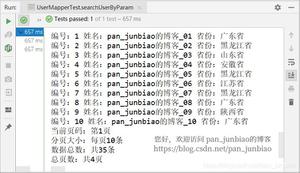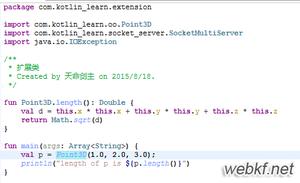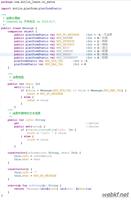025.掌握ServiceSVC基础使用

一 Service简介1.1 Service概念
Service是Kubernetes的核心概念,通过创建Service,可以为一组具有相同功能的容器应用提供一个统一的入口地址,并且将请求负载分发到后端的各个容器应用上。 1.2 Service定义详解
1 apiVersion: v1 #必须,api版本 2 kind: Service #必须,类型为Service
3 metadata: #必须,元数据
4name: string#必须,Service名称
5 namespace: string#必须,命名空间,默认为default
6 labels: #自定义标签属性列表
7 - name: string
8 annotations: #自定义注解属性列表
9 - name: string
10 spec: #必须,详细描述
11 selector: [] #必须,Label Selector配置
12 type: ClusterIP #必须,Serice类型,详见如下
13 sessionAffinity: string#虚拟服务IP地址,当选择type=ClusterIP时,若不指定,则系统进行自动分配;当type=LoadBalancer时,需要指定
14 ports: #Service需要暴露的端口列表
15 - name: string#端口名称
16 protocol: #端口协议,支持TCP和UDP,默认为TCP
17 port: int #服务监听的端口号
18 targetPort: 8080 #需要转发到后端Pod的端口号
19 nodePort: int #当spec.type=NodePort时,指定映射到物理机的端口号
20 status: #当spec.type=LoadBalancer时,设置外部负载均衡的地址,用于公有云
21 loadBalancer: #外部负载均衡器
22 ingress: #外部负载均衡器
23 ip: string#外部负载均衡器的IP地址
24 hostname: string#外部负载均衡器的主机名
spec.type:Service的类型,指定Service的访问方式,默认为ClusterIP。- ClusterIP:虚拟的服务IP地址,该地址用于Kubernetes集群内部的Pod访问,在Node上kube-proxy通过设置的iptables规则进行转发;
- NodePort:使用宿主机的端口,使能够访问各Node的外部客户端通过Node的IP地址和端口号就能访问服务;
- LoadBalancer:使用外接负载均衡器完成到服务的负载分发,需要在spec.status.loadBalancer字段指定外部负载均衡器的IP地址,并同时定义nodePort和clusterIP,用于公有云。
二 Service基本使用2.1 Service的基本用法
一般来说,对外提供服务的应用程序需要通过某种机制来实现,对于容器应用最简便的方式就是通过TCP/IP机制及监听IP和端口号来实现。 示例:定义一个提供Web服务的RC,由两个Tomcat容器副本组成,每个容器都通过containerPort设置提供服务的端口号为8080。[root@k8smaster01 study]# cat webapp-rc.yaml 1 apiVersion: v1 2 kind: ReplicationController
3 metadata:
4name: webapp
5 spec:
6 replicas: 2
7 template:
8 metadata:
9name: webapp
10 labels:
11 app: webapp
12 spec:
13 containers:
14 - name: webapp
15 image: tomcat
16 ports:
17 - containerPort: 8080
[root@k8smaster01 study]# kubectl create -f webapp-rc.yaml [root@k8smaster01 study]# kubectl get pods -l app=webapp -o yaml | grep podIP podIP: 172.24.9.88 podIP: 172.24.9.199[root@k8smaster01 study]# curl 172.24.9.88:8080
直接通过Pod的IP地址和端口号可以访问到容器应用内的服务,但是Pod的IP地址是不可靠的,例如当Pod所在的Node发生故障时,Pod将被Kubernetes重新调度到另一个Node,Pod的IP地址将发生变化。如果容器应用本身是分布式的部署方式,通过多个实例共同提供服务,就需要在这些实例的前端设置一个负载均衡器来实现请求的分发。Kubernetes中的Service就是用于解决这些问题的核心组件。Service示例:以如上webapp应用为例,为了让客户端应用访问到两个Tomcat Pod实例,可以创建一个Service来提供服务。Kubernetes提供了一种快速的方法,即通过kubectl expose命令来创建Service。[root@k8smaster01 study]# kubectl expose rc webapp[root@k8smaster01 study]# kubectl get svc | grep -E "NAME|webapp"NAME TYPE CLUSTER-IP EXTERNAL-IP PORT(S) AGEwebapp ClusterIP 10.10.10.51 <none> 8080/TCP 45s[root@k8smaster01 study]# curl 10.10.10.51:8080 #测试访问提示:如上Service地址10.10.10.51:8080的访问被自动负载分发到后端两个Pod。Service示例2:通过Service配置文件暴露服务。[root@k8smaster01 study]# vi webappsvc.yaml2 kind: Service #必须,类型为Service
3 metadata: #必须,元数据
4name: string#必须,Service名称
5 namespace: string#必须,命名空间,默认为default
6 labels: #自定义标签属性列表
7 - name: string
8 annotations: #自定义注解属性列表
9 - name: string
10 spec: #必须,详细描述
11 selector: [] #必须,Label Selector配置
12 type: ClusterIP #必须,Serice类型,详见如下
13 sessionAffinity: string#虚拟服务IP地址,当选择type=ClusterIP时,若不指定,则系统进行自动分配;当type=LoadBalancer时,需要指定
14 ports: #Service需要暴露的端口列表
15 - name: string#端口名称
16 protocol: #端口协议,支持TCP和UDP,默认为TCP
17 port: int #服务监听的端口号
18 targetPort: 8080 #需要转发到后端Pod的端口号
19 nodePort: int #当spec.type=NodePort时,指定映射到物理机的端口号
20 status: #当spec.type=LoadBalancer时,设置外部负载均衡的地址,用于公有云
21 loadBalancer: #外部负载均衡器
22 ingress: #外部负载均衡器
23 ip: string#外部负载均衡器的IP地址
24 hostname: string#外部负载均衡器的主机名
2.1 Service的基本用法
一般来说,对外提供服务的应用程序需要通过某种机制来实现,对于容器应用最简便的方式就是通过TCP/IP机制及监听IP和端口号来实现。 示例:定义一个提供Web服务的RC,由两个Tomcat容器副本组成,每个容器都通过containerPort设置提供服务的端口号为8080。[root@k8smaster01 study]# cat webapp-rc.yaml1 apiVersion: v1[root@k8smaster01 study]# kubectl create -f webapp-rc.yaml [root@k8smaster01 study]# kubectl get pods -l app=webapp -o yaml | grep podIP podIP: 172.24.9.88 podIP: 172.24.9.199[root@k8smaster01 study]# curl 172.24.9.88:80802 kind: ReplicationController
3 metadata:
4name: webapp
5 spec:
6 replicas: 2
7 template:
8 metadata:
9name: webapp
10 labels:
11 app: webapp
12 spec:
13 containers:
14 - name: webapp
15 image: tomcat
16 ports:
17 - containerPort: 8080
1 apiVersion: v1[root@k8smaster01 study]# kubectl create -f webappsvc.yaml[root@k8smaster01 study]# kubectl get svc | grep -E "NAME|webappser"NAME TYPE CLUSTER-IP EXTERNAL-IP PORT(S) AGEwebappservice ClusterIP 10.10.10.83 <none> 8081/TCP 22s提示:如上Service定义中的关键字段是ports和selector。本例中ports定义部分指定了Service所需的虚拟端口号为8081,由于与Pod容器端口号8080不一样,所以需要再通过targetPort来指定后端Pod的端口号。selector定义部分设置的是后端Pod所拥有的label:app=webapp。[root@k8smaster01 study]# curl 10.10.10.83:8081 #访问测试2 kind: Service
3 metadata:
4name: webappservice
5 spec:
6 ports:
7 - port: 8081
8 targetPort: 8080
9 selector:
10 app: webapp
- Service负载分发策略:RoundRobin和SessionAffinity
- RoundRobin:轮询模式,即轮询将请求转发到后端的各个Pod上。
- SessionAffinity:基于客户端IP地址进行会话保持的模式,即第1次将某个客户端发起的请求转发到后端的某个Pod上,之后从相同的客户端发起的请求都将被转发到后端相同的Pod上。
2.2 多端口Service
有时一个容器应用也可能提供多个端口的服务,那么在Service的定义中也可以相应地设置为将多个端口对应到多个应用服务。示例1:如下,Service设置了两个端口号,并且为每个端口号都进行了命名。[root@k8smaster01 study]# vi twoportservice.yaml1 apiVersion: v1[root@k8smaster01 study]# vi kubednsservice.yaml2 kind: Service
3 metadata:
4name: webapp
5 spec:
6 ports:
7 - port: 8080
8 targetPort: 8080
9name: web
10 - port: 8005
11 targetPort: 8005
12name: management
13 selector:
14 app: webapp
1 apiVersion: v12 kind: Service
3 metadata:
4name: kube-dns
5 namespace: kube-system
6 labels:
7 k8s-app: kube-dns
8 kubernetes.io/cluster-service: "true"
9 kubernetes.io/name: "KubeDNS"
10 spec:
11 selector:
12 k8s-app: kube-dns
13 clusterIP: 169.169.0.100
14 ports:
15 - name: dns
16 port: 53
17 protocol: UDP
18
19 - name: dns-tcp
20 port: 53
21 protocol: TCP
2.3 外部服务Service
在某些环境中,应用系统需要将一个外部数据库、另一个集群或Namespace中的服务作为服务的后端,则可通过创建一个无Label Selector的Service来实现。[root@k8smaster01 study]# vi noselectorservice.yaml1 apiVersion: v1[root@k8smaster01 study]# kubectl create -f noselectorservice.yaml如上定义创建的是一个不带标签选择器的Service,即无法选择后端的Pod,系统不会自动创建Endpoint,因此需要手动创建一个和该Service对应的Endpoint,用于指向实际的后端访问地址。如下所示的Endpoint的定义文件:[root@k8smaster01 study]# vi noselectorendpoint.yaml2 kind: Service
3 metadata:
4name: my-service
5 spec:
6 ports:
7 - protocol: TCP
8 port: 80
9 targetPort: 80
1 apiVersion: v1[root@k8smaster01 study]# kubectl create -f noselectorendpoint.yaml[root@k8smaster01 study]# kubectl get svc | grep -E "NAME|my-service"NAME TYPE CLUSTER-IP EXTERNAL-IP PORT(S) AGEmy-service ClusterIP 10.10.10.211 <none> 80/TCP 3s[root@k8smaster01 study]# curl 10.10.10.211提示:如上所示,访问没有标签选择器的Service和带有标签选择器的Service一样,请求将会被路由到由用户手动定义的后端Endpoint上。2 kind: Endpoints
3 metadata:
4name: my-service
5 subsets:
6 - addresses:
7 - IP: 47.96.145.131
8 ports:
9 - port: 80
三 Headless Service3.1 无头服务简介
在某些应用场景中,若需要人为指定负载均衡器,不使用Service提供的默认负载均衡的功能,或者应用程序希望知道属于同组服务的其他实例。Kubernetes提供了Headless Service来实现这种功能,即不为Service设置ClusterIP(入口IP地址),仅通过Label Selector将后端的Pod列表返回给调用的客户端。此场景中,Service就不再具有一个特定的ClusterIP地址,对其进行访问将获得包含Label“app=nginx”的全部Pod列表,然后客户端程序自行决定如何处理这个Pod列表。例如,StatefulSet就是使用Headless Service为客户端返回多个服务地址的。对于“去中心化”类的应用集群,Headless Service非常适合。3.2 Nginx场景实验
通过对Headless Service搭建Nginx集群,从而自动实现应用集群的创建。[root@k8smaster01 study]# vi nginx-service.yaml #创建Service 1 apiVersion: v1 2 kind: Service
3 metadata:
4 labels:
5name: nginx-svc
6name: nginx-svc
7 spec:
8 ports:
9 - protocol: TCP
10 port: 80
11 targetPort: 80
12 selector:
13name: nginx-demo #定义selector
14 clusterIP: None
[root@k8smaster01 study]# kubectl create -f nginx-service.yaml[root@k8smaster01 study]# vi nginx-deployment.yaml 1 apiVersion: apps/v1 2 kind: Deployment
3 metadata:
4 labels:
5name: nginx-demo
6name: nginx-demo
7 spec:
8 replicas: 2
9 selector:
10 matchLabels:
11name: nginx-demo
12 template:
13 metadata:
14 labels:
15name: nginx-demo
16 spec:
17 containers:
18 - name: nginx
19 image: nginx:1.7.9
20 ports:
21 - containerPort: 80
22name: web
[root@k8smaster01 study]# kubectl create -f nginx-deployment.yaml[root@k8smaster01 study]# kubectl create -f nginx-service.yaml[root@k8smaster01 study]# kubectl get svc -o wide[root@k8smaster01 study]# kubectl get pods -o wide [root@k8smaster01 study]# nslookup nginx-svc.default.svc.cluster.local 10.10.190.170提示:由上可知,通过解析SVC的地址,直接解析出来的为Pod的IP。
2 kind: Service
3 metadata:
4 labels:
5name: nginx-svc
6name: nginx-svc
7 spec:
8 ports:
9 - protocol: TCP
10 port: 80
11 targetPort: 80
12 selector:
13name: nginx-demo #定义selector
14 clusterIP: None
2 kind: Deployment
3 metadata:
4 labels:
5name: nginx-demo
6name: nginx-demo
7 spec:
8 replicas: 2
9 selector:
10 matchLabels:
11name: nginx-demo
12 template:
13 metadata:
14 labels:
15name: nginx-demo
16 spec:
17 containers:
18 - name: nginx
19 image: nginx:1.7.9
20 ports:
21 - containerPort: 80
22name: web
以上是 025.掌握ServiceSVC基础使用 的全部内容, 来源链接: utcz.com/z/514286.html









